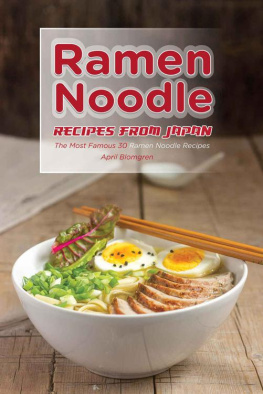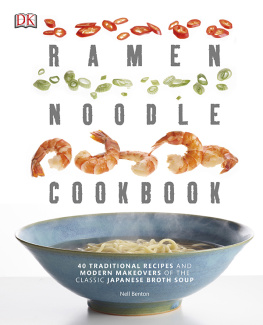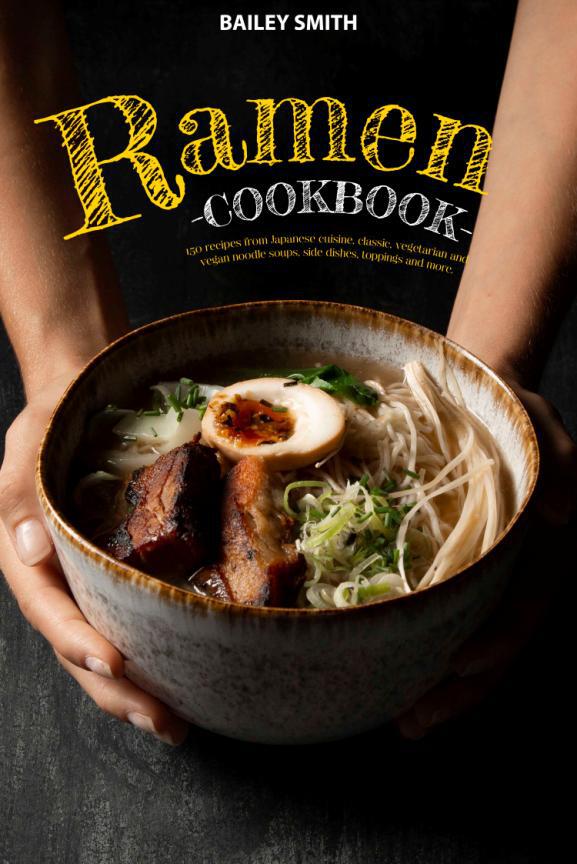Table of Contents
Ramen cookbook
150 recipes from Japanese cuisine, classic, vegetarian and vegan noodle soups, side dishes, toppings and more.
Author: Bailey Smith
Table of Contents
Preface
Although the noodle soup originally comes from China, it has become an integral part of Japanese cuisine today. The Japanese took it over in the 19th century, developed it further and made it into a dish of its own, as they have already done with other dishes.
The Japanese noodle soup trend has now established itself all over the world and you can even find Japanese ramen restaurants in China.
The four ingredients sauce, soup, pasta and toppings correspond to the four ingredients in our life: our family, the environment in which we live, our calling and our dreams.
What are ramen?
Japanese ramen are yellowish wheat noodles of Chinese origin. The classic Japanese noodles can be easily recognized by their rich, yellow color and their wavy appearance even when cooked. Both the noodles and the finished noodle soup are known as ramen. The standard noodle soup consists of noodles, a spicy broth and various side dishes (toppings) that are draped on top. In Japan, there are countless variations of the soup, e.g. depending on local preferences and regional ingredients.
Ramen soups are very filling, which is mainly due to the high protein content in the toppings, and less to the high fat content. In Japan, ramen is much more than just a simple noodle soup, it borders on a culinary obsession. This does not just mean instant ramen ("cup noodels"), but perfection from a single bowl. From the firm noodles to selected side dishes such as waxy eggs and tender pork.
Restaurants that serve ramen are called ramen-ya. Every ramen-ya differs from region to region but also from restaurant to restaurant. There is actually no such thing as a ramen recipe, just a kit that specifies the five components of the soup.
The five ingredients of ramen soup:
- Ramen noodle s
- brot h
- Tar e
- side dishe s
- topping s
Attention should be paid to each ingredient so that a balanced and delicious soup is created.
Selection and preparation of the ramen noodles
What are ramen noodles made of?
Japanese ramen noodles traditionally consist of three essential ingredients: gluten-rich flour for the structure, Kansui water for the texture and color and egg yolk for the elasticity of the noodles.
In most cases, wheat flour, which is high in gluten, is used as the basis for making pasta.
Kansui refers to the water from Lake Kan in Inner Mongolia. The Kan Lake water has very high proportions of potassium and sodium carbonate. Together with traces of phosphoric acid in the kansui, this originally colored the ramen noodles yellow and gave them their special taste. The water can be bought in Japan as bottled bottles, although nowadays mostly artificially produced Kansui water is used. Outside of Japan and in the country itself, baking soda (baked soda) is mainly used for preparation today.
The use of egg yolk differs from recipe to recipe - sometimes it is used and sometimes vegan ramen noodles are made without eggs. Here everyone can decide according to their individual preferences.
But the result is always the same on the outside: They are long, elastic and usually slightly wavy. There are larger, especially regional, differences in the strength of the pasta (from very thin to thick) and how cooked it is (medium or firm).
What types of ramen are there?
Basically, Japanese cuisine differentiates between four different types of ramen, which are also available in this country:
The Japanese names in the following will definitely help you to recognize your favorite frames in the supermarket or Asia shop more quickly and then cook them properly.
In Japan, it is customary to rinse the cooked noodles under ice-cold water. This removes the starch from the surface of the pasta and makes slurping much easier.
Noodle type 1: Namamen (fresh / raw)
You can make fresh ramen noodles (Namamen ) yourself. There is a great recipe on page xx.
In general, the cooking instructions on the packaging should always be followed when purchasing ramen noodles. However, if there are no instructions, fresh pasta (depending on the strength) is placed in boiling water (not in the broth, but in a separate saucepan) for about 45 seconds.
Before they are removed from the boiling water, they should be checked for cooking. If the pasta is not done yet (it feels a little like rubber in your mouth), let it cook for another 30 seconds and check again.
Fresh pasta (whether homemade or bought) should always be kept in the refrigerator. Purchases should not be frozen unless they have already been bought frozen. Homemade ramen noodles should also be frozen in less than an hour after preparation. Again, thawed pasta should not be frozen again.
Noodle type 2: Mushimen (steamed)
Steamed ramen (mushimen ) are preferred for yakisoba recipes because their consistency is perfect for frying.
Their cooking time is between 45 seconds and 1 minute. Regarding their storage, the same procedure should be used as with fresh pasta. Conveniently, there are mushrooms to buy in pre-portioned bags so that there should be no leftovers.
Noodle type 3: Kanmen (dried)
For an authentic Japanese ramen noodle soup, dried ramen are particularly suitable because they are ready to cook in a few moments, absorb the flavor of the broth particularly well and have a very good shelf life.
Dried ramen noodles (Kanmen ) should be cooked for about 2 to 3 minutes.
This variety is almost indestructible. They can be stored directly on the storage shelf. An opened package should not be placed open back on the shelf, but closed airtight (and ideally together with the drying agent).
Noodle type 4: Insutanto Ramen (instant)
Instant noodles are cooked directly in the broth and not in a separate water bath because, unlike the previous types, they can absorb a lot more of the soup and gain in flavor.
Therefore, sufficient liquid should be planned here (unless the instructions on the packaging indicate otherwise).
Where can you buy ramen noodles?
Fresh ramen are hard to find in Germany, which is a shame but unfortunately cannot be changed.
The dried ramen is available in well-stocked supermarkets and in the Asia shop near you.
Preparation of the broth
The basis (in addition to the noodles) is the hot broth. It is only through this that the best of the remaining ingredients is brought out and a full taste is created.
Portioning: Allow around 250 ml of broth per serving.
The broth does not have to be of animal origin like a Tonkotsu broth (based on boiled pork bones), but can also be based on vegetarian ingredients such as kombu or shiitake.
What do Kotteri and Assari mean?
All broths can be divided into two categories - depending on the intensity (heaviness vs. lightness) of their taste - in Kotteri and Assari. Ever heard
Kotteri describes a rich, cloudy and thick broth. The already used example of a Tonkotsu broth is a perfect case for this. Kotteri broths are packed full of good fats, minerals and proteins that come from bones that are mostly boiled for a long time.
Assari broths can be described as rather thin, light and clear. A good example here is a dashi broth, which we will discuss in a moment. Broths, which are called Assari, get their aromas mostly from cooked vegetables and fish or short and gently cooked bones.











